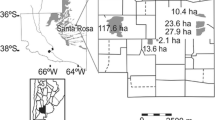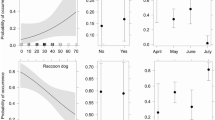Summary
The predation rate of artificial bird nests was measured in disturbed chaparral habitat fragments and at an unfragmented site in coastal San Diego County, California USA. Local extinctions of chaparral birds has been previously shown to occur in these fragments. The predation rate was highest at the unfragmented site. Among fragments, predation was higher at moderately disturbed than at highly disturbed sites. These results suggest that nest predator species diversity or density is reduced in disturbed chaparral fragments. Nest predation is probably not the most important cause of the observed loss of chaparral breeding bird diversity in these fragments.
Similar content being viewed by others
References
Andrén H, Angelstam P, Lindström E, Widén P (1985) Differences in predation pressure in relation to habitat fragmentation. Oikos 45:273–277
Atkinson IAE (undated) Evidence for effects of rodents on the vertebrate wildlife of New Zealand islands. Botany Division, DSIR
Blake JG, Karr JR (1987) Breeding birds of isolated woodlots: area and habitat relationships. Ecology 68:1724–1734
Bolger DT, Alberts AC, Soulé ME (1991) Bird species occurrence patterns in habitat fragments: sampling, extinction, and nested species subsets. Am Nat (in press)
Brittingham MC, Temple SA (1983) Have cowbirds caused forest songbirds to decline? Bioscience 33:31–35
Croze H (1970) Searching image in carrion crows. Z Tierpsych 5:1–85
DeSante D (1982) Nests and nest predation in landbirds. P R B O Newsletter 59:1–5
Fitzgerald BM, Karl BJ (1979) Foods of feral house cats (Felis catus L.) in forest of the Orongorongo Valley, Wellington. N Z J Zool 6:107–126
Galli AE, Leck CF, Forman RT (1976) Avian distribution patterns in forest islands of different sizes in central New Jersey. Auk 93:356–365
George TL (1987) Greater land bird densities on island vs. mainland: relation to nest predation level. Ecology 68:1393–1400
Gottfried BM (1978) Anti-predator aggression in birds nesting in old field habitats: an experimental analysis. Condor 81:251–257
Harrison C (1978) A field guide to the nests, eggs, and nestlings of North American birds. Collins, New York
Harrison HH (1979) A field guide to western birds' nests. Peterson RT (ed) The Peterson Field Guide Series. Houghton Mifflin, Boston
Hoffman CO, Gottschang JL (1977) Numbers, distribution, and movements of a racoon in a suburban residential community. J Mamm 58:623–636
Hubbs EL (1951) Food habits of feral house cats in the Sacramento Valley. Calif Fish Game 37:177–189
Justice KE (1961) A new method for measuring home ranges of small mammals. J Mamm 42:462–470
Leigh EG Jr (1981) The average lifetime in a varying environment. J Theor Biol 90:213–239
Liberg O (1984) Food habits and prey impact by feral and house-based domestic cats in a rural area of southern Sweden. J Mamm 65:424–432
Loiselle BA, Hopper WG (1983) Nest predation in insular and mainland lowland rainforest in Panama. Condor 85:93–95
MacArthur RH, Wilson EO (1967) The theory of island biogeography. Princeton University Press, Princeton NJ
Martin TE (1987) Artificial nest experiments: effects of nest appearance and type of predator. Condor 89:925–928
Martin TE (1988a) Habitat and area effects on forest bird assemblages: is nest predation an influence. Ecology 69:74–84
Martin TE (1988b) Processes organizing open-nesting bird assemblages: competition or nest predation? Evol Ecol 2:37–50
Martin TE (1988c) On the advantage of being different: Nest predation and the coexistence of bird species. Proc Natl Acad Sci USA 85:2196–2199
Matthaie PE, Stearns F (1981) Mammals in forest islands in southeastern Wisconsin forest fragments. In: Burgess RL, Sharpe F (eds) Forest island dynamics in man-dominated landscapes. Springer-Verlag, New York, pp 55–66
Maxson SJ, Oring LW (1978) Mice as a source of egg loss among ground nesting birds. Auk 95:582–584
Mayfield H (1977) Brown-headed cowbird: agent of extermination? Am Birds 31:107–113
Møller AP (1987) Egg predation as a selective factor for nest design: an experiment. Oikos 50:91–94
Møller AP (1989) Nest site selection across field-woodland ecotones: the effect of nest predation. Oikos 56:240–246
Nilsson SG, Borkman G, Forslund P, Hogland J (1985) Egg predation on forest bird communities on islands and mainland. Oecologia 66:511–515
Norman FI (1975) The murine rodents Rattus rattus, exulans, and norvegicus as avian predators. Atoll Res Bull 182:1–13
Rappole JH, Morton ES (1985) Effects of habitat alteration on a tropical avian community. Ornith Monog 36:1013–1021
Rauzon MJ (1985) Feral cats on Jarvis island: their effects and their eradication. Atoll Res Bull 282:1–30
Ricklefs RE (1969) An analysis of nest mortality in birds. Smithsonian Contr Zool 9:1–48
Robbins CS (1979) Effect of forest fragmentation on bird populations. U. S. Forest Service. NTIS, N C 51
Robbins CS (1980) Effects of forest fragmentation on breeding bird populations in the Mid Atlantic region. Atlant Natur 33:31–36
Small MF, Hunter ML (1988) Forest fragmentation and avian nest predation in forested landscapes. Oecologia 76:62–64
Soulé ME, Bolger D, Alberts AC, Wright J, Sorice M, Hill S (1988) Reconstructed dynamics of rapid extinctions of chaparral-requiring birds in urban habitat islands. Conserv Biol 2:75–92
Terborgh J (1989) Where have all the birds gone? Princeton University Press, Princeton NJ
Unitt P (1978) The Birds of San Diego County, San Diego Society of Natural History, San Diego
Whitcomb RF, Robbins SS, Lynch JF, Whitcomb BL, Klimkiewicz MK, Bystrak D (1981) Effects of forest fragmentation on avifauna in eastern deciduous forest. In: Burgess RL, Sharpe DM (eds) Forest island dynamics in man-dominated landscapes. Springer-Verlag, New York, pp 125–292
Wilcove DS (1985b) Nest predation in forest tracks and the decline of migratory songbirds. Ecology 66:1211–1214
Wilcove DS, McLellan CH, Dobson AP (1986) Habitat fragmentation in the temperate zone. In: Soulé ME (ed) Conservation biology. Sinauer, Sunderland MA, 237–256
Willis EO (1974) Populations and local extinctions of birds on Barro Colorado, Panama. Ecol Monog 44:153–169
Willis EO (1979) The composition of avian communities in remanescent woodlots in southern Brazil. Papeis Avulsos Zool 33:1–25
Yahner RH, Cypher BL (1987) Effects of nest location on depredation of artificial arboreal nests. J Wildl Manage 51:178–181
Yahner TH, Morell TE, Rachael JS (1989) Effects of edge contrast on depredation of artificial avian nests. J Wildl Manage 53:1135–1138
Yahner RH, Scott DP (1988) Effects of forest fragmentation on depredation of artificial nests. J Wildl Manage 52:158–161
Yahner RH, Voytko RA (1989) Effects of nest-site selection on depredation of artificial nests. J Wildl Manage 53:21–25
Yahner RH, Wright AL (1985) Depredation on artificial ground nests: effects of edge and plot age. J Wildl Manage 49:508–513
Author information
Authors and Affiliations
Rights and permissions
About this article
Cite this article
Langen, T.A., Bolger, D.T. & Case, T.J. Predation on artificial bird nests in chaparral fragments. Oecologia 86, 395–401 (1991). https://doi.org/10.1007/BF00317607
Received:
Accepted:
Issue Date:
DOI: https://doi.org/10.1007/BF00317607




